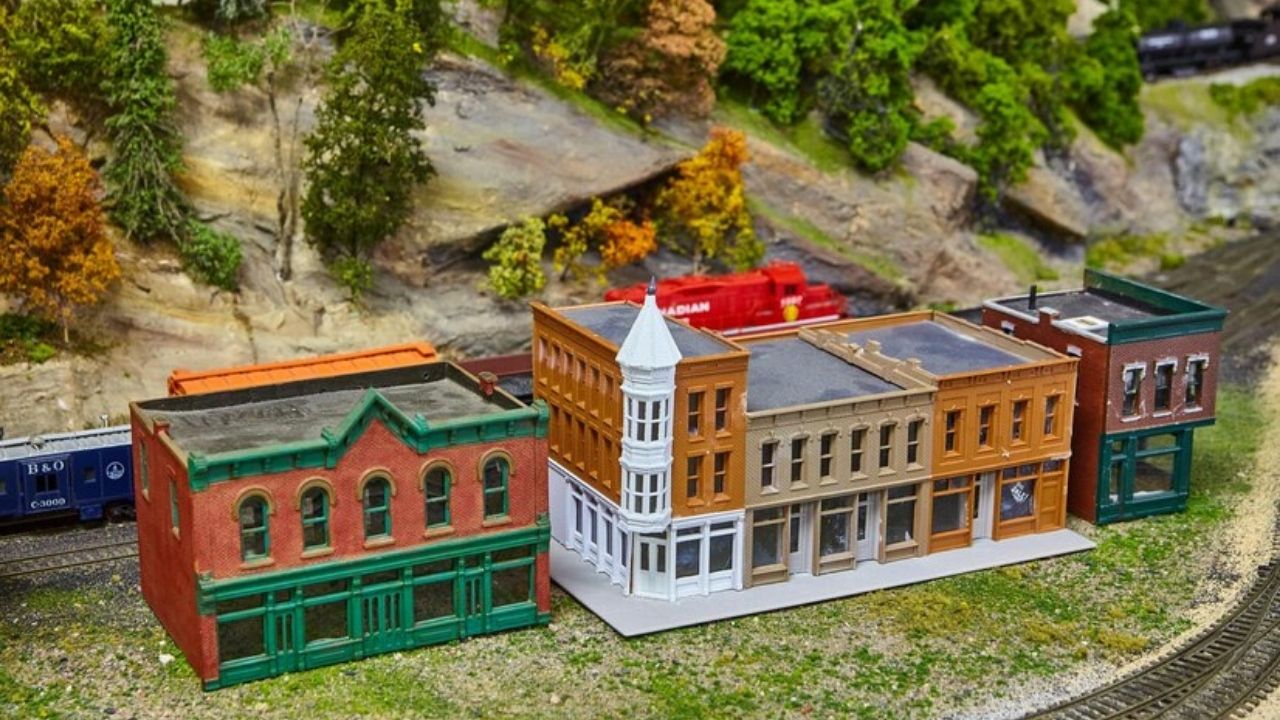BLOG
How to Customize and Build the Gloor Craft Models Kit 410 Freight House HO Scale

Model train enthusiasts and hobbyists know the joy of recreating a slice of history through their layouts. The Gloor Craft Models Kit 410 Freight House HO Scale is not just any piece; it’s a gateway to enriching your model world with nostalgic charm, intricate spaces, and a rewarding challenge. Whether you’re a seasoned builder or someone looking to level up your hobby, this kit offers a balance of creativity and craftsmanship.
This guide will take you through the customization and building process, step by step. From prepping your space to personalizing final details, get ready to transform a collection of parts into a stunning centerpiece that echoes the legacy of classic railroads.
Why the Gloor Craft Models Kit 410 Is an Enthusiast Favorite
Before we dig into the building details, let’s take a moment to appreciate what makes this kit special. The Gloor Craft Models Kit 410 Freight House HO Scale represents more than just another building in your layout—it serves as a hub of activity, the connective tissue of commerce and industry in any town. Its HO scale (1:87) fits perfectly with your standard model train setup, and its design harks back to the quaint, hardworking freight houses of yesteryears.
Crafted with precision and detail, the Gloor Craft Models Kit 410 Freight House HO Scale provides pre-cut wooden parts to assemble a robust and authentic structure. The challenge? Bringing it to life with thoughtful customization, painting, and weathering. This kit is a canvas for your imagination.
Getting Started with Your Model
Step 1: Gather Your Materials
Before you get started, make sure you have all the necessary tools and materials on hand. Here’s a checklist to help you prepare:
- Basic tools: Hobby knife, fine-toothed saw, tweezers, and sandpaper (medium and fine grit).
- Adhesives: Wood glue or tacky glue for assembly, and super glue for smaller elements that need a firm hold.
- Paints: Acrylic paints in your desired colors for the base coat and details. Consider earthy tones or muted shades for a classic, weathered look.
- Weathering supplies: Weathering powders or chalk, fine brushes, and sponges to create a realistic aged effect.
- Lighting (optional): Tiny LED lights to illuminate the interior for added realism.
- Workspace prep: Use newspaper or a cutting mat to protect your workspace and ensure you work in a well-lit, ventilated area.
Having everything within reach will not only make the process smoother but reduce interruptions as you work through the intricate details.
Step 2: Review the Instructions
Take a moment to lay out all the pieces and review the instruction manual included in the kit. Think of this as familiarizing yourself with your “blueprint.” While the parts are pre-cut, it’s helpful to visualize how they fit together before you start applying glue.
Pro Tip: Label each piece using sticky notes or small tags. Trust us, spending a few minutes up front will save you time and frustration during assembly.
Building the Freight House
Step 3: Assemble the Base and Walls
The Freight House kit comes with sturdy wooden pieces that form the foundation of the structure. Start by assembling the base and walls:
- Sand all edges to ensure smooth, precise fits.
- Apply wood glue sparingly along joints—too much will ooze out and could damage the finish.
- Hold pieces together using clamps or rubber bands while the glue sets.
Once the main walls are up, step back and admire the skeletal shape of your Freight House. It’s already starting to take form, but there’s still plenty of charm to add.
Step 4: Add the Roof and Details
Now it’s time to assemble the roof and smaller details like windowsills, doors, and freight platforms.
- Score or sand the roof edges for a snug fit.
- Attach doors or shutters slightly ajar for a touch of realism, as if the house is in active use.
- Use tweezers for small details like window panes or handles to ensure precision placement.
Step 5: Paint the Structure
Painting is where the Freight House begins to truly reflect your creative vision. Start with a base coat:
- Use neutral or muted tones for the walls, such as browns, grays, or faded reds, to mimic the look of aged wood.
- Add complementary or contrasting colors to the trim, doors, and roof for visual interest.
Pro Tip: Use multiple thin layers rather than a single thick one. Thinner layers dry evenly and prevent unsightly clumps or brush marks.
Step 6: Create Realism with Weathering
No freight house stays pristine forever. Weathering techniques will ensure your model feels like it’s lived a life full of stories.
- Apply weathering powder or chalk along the edges, corners, and roof to add “dirt” or “soot.”
- Use a sponge or fine brush and dab streaks of dark gray or brown paint to create the appearance of wear and tear.
- Add rust effects on metal parts or water stains running vertically from gutters.
Subtlety is key—too much weathering can overpower your structure, while just enough will make it look authentic.
Customization and Personal Touches
Interior Additions
Want to make your Freight House stand out? Consider incorporating an interior scene. Add wooden crates, barrels, tools, or miniature workers to emphasize its functionality.
Illuminating the Space
Tiny LED lights can transform your model. Place them inside the Freight House for a warm, inviting glow, making your layout even more captivating in dim settings.
Landscaping
Finally, build its surrounding environment. Cobblestone paths, wild grass, and small props—like mail carts or bicycles—add charm and context to your Freight House.
Sharing Your Masterpiece
Celebrate your finished Freight House by showcasing it in your layout or as a stand-alone exhibit. Take photos to document your hard work, and share them with model-building communities online. You’ll inspire others while receiving tips and encouragement for your future builds.
Build, Customize, and Explore New Horizons in Modeling
The Gloor Craft Models Kit 410 Freight House HO Scale isn’t just a project—it’s a doorway to creativity and a showcase of your personal craftsmanship. Every coat of paint, every weathered detail, every miniature accessory tells a story that you brought to life.
Whether you’re a hobbyist or a passionate collector, you’ve now added something unique to your world. And there’s no better feeling than seeing that creation sit proudly in your layout, knowing that every element was shaped by your hands.
Take on the challenge. Build, customize, and create something extraordinary.
BLOG
How Office Chairs Influence Workplace Collaboration and Communication

The design of an office environment plays a significant role in shaping the culture and productivity of a workplace. Among the many elements that contribute to a productive workspace, office chairs stand out as one of the most influential factors in fostering collaboration and communication. The comfort, functionality, and ergonomics of office chairs directly impact how employees interact with each other, how meetings are conducted, and the overall atmosphere of the workplace.
Comfort and Communication Flow
One of the primary ways office chairs influence communication is through comfort. When employees are comfortable, they are more likely to engage in open conversations, collaborate freely, and contribute ideas during meetings. Uncomfortable seating can lead to distractions, with employees shifting positions or feeling restless, which ultimately hampers their ability to focus and participate.
An ergonomic office chair provides support, helping individuals maintain good posture for longer periods. This encourages active participation in discussions, as employees are less likely to feel fatigued or distracted by physical discomfort. For example, an office chair with lumbar support helps prevent back strain, allowing individuals to stay focused on the conversation instead of shifting uncomfortably.
Facilitating Informal Interactions
Collaboration doesn’t just happen during scheduled meetings or brainstorming sessions. Many innovative ideas are born from spontaneous conversations between colleagues. Office chairs that are mobile, lightweight, and flexible enable employees to move around the workspace and interact with others easily. Chairs on wheels, for instance, allow team members to move between workstations, gather around shared spaces, or engage in impromptu discussions without disrupting the flow of work.
In open-plan offices, where informal communication is often the norm, flexible office chairs can encourage greater movement and interaction. A collaborative environment is more likely to thrive when employees can comfortably engage with one another without feeling restricted by their seating arrangement. The ability to move easily between colleagues fosters a more connected and communicative workplace culture.
Impact on Meeting Dynamics
Meetings are a critical aspect of collaboration and communication in any organisation. The type of office chair used in meeting rooms can greatly influence the effectiveness of these discussions. Comfortable, adjustable chairs that allow participants to sit for extended periods without discomfort can help maintain focus during long meetings.
Moreover, the layout of the seating arrangement is essential. Circular or semi-circular seating arrangements encourage equal participation, as every person can face one another directly. This layout, paired with ergonomic office chairs, ensures that all team members can engage comfortably in discussions without being hindered by physical discomfort.
Additionally, chairs with swivel features allow individuals to easily rotate and engage with others, promoting a dynamic exchange of ideas. A flexible seating arrangement in a meeting room can make a huge difference in how effectively information is communicated and ideas are shared.
Encouraging Team Collaboration in Breakout Areas
While much of the focus is on individual workspaces, breakout areas also play a crucial role in fostering collaboration. These spaces are designed for team discussions, brainstorming, and creative thinking. Comfortable and versatile office chairs in these areas help teams come together and communicate effectively.
For example, lounge-style chairs or collaborative seating arrangements can create a more relaxed and open atmosphere, encouraging creativity and idea-sharing. In these settings, employees are more likely to feel comfortable expressing their thoughts, leading to increased collaboration and more productive discussions.
The right office furniture, such as chairs designed for group settings, can transform a simple break room into a productive collaborative space, allowing teams to engage in brainstorming sessions and problem-solving discussions away from their desks.
Promoting Well-being and Mental Health
Employee well-being is intrinsically linked to productivity and collaboration. A comfortable office chair that supports good posture and reduces strain can contribute significantly to mental and physical well-being. When employees feel well-supported, they are more likely to have positive interactions with colleagues, engage in team activities, and contribute to the workplace culture.
Furthermore, office chairs that promote health and comfort can reduce stress levels. High-quality ergonomic chairs can minimise the risk of musculoskeletal disorders, which can lead to chronic pain and reduced mobility. This ensures that employees remain in good health, allowing them to participate fully in team activities, meetings, and collaborative efforts.
In addition to physical comfort, office chairs that provide a sense of personal space can help employees feel more secure and confident in their work environment. This sense of security encourages open communication and collaboration, as employees are less likely to feel distracted or stressed by their surroundings.
The Role of Office Furniture in Workplace Design
The design of office furniture, including chairs, plays a significant role in creating an environment that fosters communication and collaboration. Thoughtfully designed office furniture supports the dynamic needs of modern workspaces, where collaboration, flexibility, and mobility are key.
For instance, office chairs that are adjustable allow employees to customise their seating to suit their individual preferences, which enhances both comfort and productivity. When employees are comfortable, they are more likely to engage in collaborative activities and share their ideas with colleagues. Additionally, office furniture that promotes openness, such as chairs with transparent materials or modular designs, encourages communication by making the environment feel more inviting and accessible.
Conclusion: Creating a Collaborative Culture Through the Right Office Chairs
In conclusion, office chairs are not just functional pieces of furniture; they are pivotal to the overall dynamics of workplace collaboration and communication. From encouraging informal interactions to facilitating effective meetings, the right office chair can significantly enhance how employees connect and work together. When paired with thoughtful office furniture design, ergonomic and comfortable seating creates an environment that promotes well-being, reduces distractions, and fosters a culture of collaboration. By investing in quality office chairs, businesses can improve communication, teamwork, and overall productivity in the workplace.
BLOG
Why Choosing the Right Top Coat Can Transform Your Building’s Appearance

When it comes to home and building maintenance, ensuring long-lasting protection and aesthetic appeal is crucial. A top coat can decide whether your exterior surfaces remain resilient against the elements or show signs of wear over time. While many may not pay much attention to the materials used for this layer, they play a pivotal role in your structure’s protection and appearance. Not only does the right top coat improve durability, but it also adds a finishing touch that elevates the overall aesthetic. In today’s market, various options are available, each offering unique benefits for different surfaces and conditions. Selecting the best product requires careful consideration of weather resistance, ease of application, and compatibility with the surface beneath. Let’s examine how a well-chosen top coat can make all the difference.
Factors to Consider When Choosing a Top Coat
When selecting a top coat for your building, several key factors must be considered. First and foremost, you need to consider the material of your existing surfaces. Whether you’re working with rendered walls, masonry, or other building materials, your top coat must be compatible. The weather conditions in your area will also play a significant role in this decision. For example, areas that experience heavy rainfall or extreme temperatures require a top coat to withstand these stresses. Additionally, the finish of the top coat can impact not only the look of the building but also how easily it repels dirt, mold, and other environmental contaminants.
How a Silicone Top Coat Protects Your Surfaces
A silicone-based top coat is one of the most effective exterior protection solutions. Silicone offers exceptional resistance to water penetration, which makes it ideal for protecting surfaces in areas with high humidity or frequent rainfall. This material forms a flexible, breathable layer that prevents cracking, peeling, or flaking. Additionally, silicone is known for its ability to withstand UV rays, helping to maintain the vibrancy and integrity of the surface beneath for extended periods. With products like those offered by Licata, you can ensure that your building will be well-protected from the damaging effects of weather while retaining its aesthetic appeal.
The Long-Term Benefits of Using a Quality Top Coat
Investing in a high-quality top coat is not just about immediate protection. Over time, this layer will continue safeguarding your building from environmental wear, reducing the need for frequent maintenance or repairs. A durable top coat can also help to keep your building looking fresh and new, minimizing the need for touch-ups or reapplications. This long-term benefit translates to cost savings, as you won’t have to worry about the same level of maintenance. Furthermore, a well-maintained building with a strong top coat can boost its overall value, making it a wise investment for residential and commercial properties.
Application Tips for a Smooth Finish
When applying a top coat, following the correct steps is crucial to ensure a smooth and even finish. First, ensure the surface is clean and free of dust or debris. Any imperfections in the surface should be repaired before applying the top coat. Once the surface is ready, apply the top coat using the recommended tools, such as brushes or rollers, depending on the product instructions. Following the manufacturer’s guidance is essential to avoid uneven coverage or bubbling. Additionally, consider the weather conditions when applying the top coat, as extreme temperatures or humidity can affect the curing process.
Why Timely Application Matters
Applying a top coat on time can prevent long-term damage to your building’s exterior. Delaying the application could allow moisture to seep into the underlying layers, which can lead to structural damage over time. A timely application also prevents the surface from exposure to the harsh effects of UV rays, dirt, and other environmental factors. This early intervention ensures that your building remains in top condition, with minimal weather-related damage or wear risk. Don’t wait for the signs of deterioration to appear—apply your top coat immediately for the best results.
Choosing the right top coat can be a game-changer for your building’s longevity and curb appeal. A product that offers superior protection against the elements will enhance the exterior and save you time and money in the long run. Licata provides a range of silicone-based top coats designed to keep your building looking pristine while ensuring it’s protected for years to come. Don’t hesitate to explore the options that best suit your needs and make the right choice today!
BLOG
How a Small Business Improved Security with Access Control

In today’s challenging economic environment, security remains a top priority for businesses of every size. Small businesses, in particular, often look for cost-effective yet robust solutions to secure their premises without incurring excessive overheads. One strategic move that has proved beneficial is adopting electronic access control systems Orlando. By integrating such systems, businesses enhance their security, safeguarding their assets and employees against potential threats.
The Security Landscape for Small Businesses
Small businesses are more frequently targeted by security breaches than larger counterparts due to perceived vulnerabilities, so adequate protection is critical. Many businesses have realized the potential of access control systems in reducing unauthorized entries and monitoring activities, which collectively contribute to a safer business environment. These systems provide seamless control over who can access certain areas within a facility, ensuring that only authorized personnel are granted entry.
Types of Access Control Systems
Biometric Systems
Biometric systems offer high security by using individuals’ unique biological characteristics for access. This makes them ideal for small businesses handling sensitive data.
Card-based Access
Card-based access is popular in workplaces because it is convenient and easy to use. Employees can use these to enter authorized areas efficiently.
Mobile Access and Keypad Systems
Mobile access solutions turn smartphones into digital keys, offering flexibility in rapidly changing work environments. Meanwhile, keypad systems provide an intuitive entry method using codes that can be easily managed and updated.
Benefits of Implementing Access Control
Adopting an access control system yields numerous benefits for small businesses. Here are a few key advantages:
- Enhanced Security: These systems protect premises against unauthorized intrusions, preventing potential losses.
- Operational Efficiency: By automating entry processes, businesses can streamline operations, freeing up resources to focus on core tasks.
- Data-Driven Insights: Advanced systems capture access data, allowing owners to analyze trends and enhance security planning.
Integration with Smart Technology
Combining access control systems with smart technology unlocks further potential for operational efficiencies. Features such as remote management, real-time monitoring, and instant alerts allow business owners to maintain oversight over security operations even from offsite locations.
Considerations for Access Control Systems
Choosing the right access control system requires a careful evaluation of several factors, including budget, compliance, and the business’s specific security needs. Longevity and adaptability are also crucial considerations, as the business may evolve and require systems that can scale accordingly.
Future Trends in Access Control Systems
As technology continues to advance, the incorporation of artificial intelligence in access control could revolutionize security protocols. A recent study on AI’s influence on security systems explored the potential for enhanced analytical capabilities, indicating great promise for future developments that are both responsive and predictive.
Conclusion
Access control systems protect small businesses against unauthorized access and potential breaches. Owners can boost their security posture by thoughtfully selecting and implementing a system that fits specific business needs. While the initial investment may present a financial commitment, the long-term peace of mind and operational benefits offer immeasurable value. The integration of AI and smart technologies will bring further advancements, setting a new benchmark for business security solutions.
-

 BLOG8 months ago
BLOG8 months agoTribute Printed Pics: Top 10 Ways to Honor Loved Ones
-

 NEWS8 months ago
NEWS8 months agoNEWS JoTechGeeks: How to Stay Updated with the Latest News
-

 BLOG6 months ago
BLOG6 months agoThe //Vital-Mag.net Blog: Your Daily Dose of Inspiration
-

 ENTERTAINMENT9 months ago
ENTERTAINMENT9 months agoFreemoviesfull.cc: Ultimate Guide
-

 HEALTH9 months ago
HEALTH9 months ago2023-1954: Enhancing Health and Vitality
-

 TECH8 months ago
TECH8 months agoWww abithelp .com: Your Ultimate Online Assistance Platform
-

 HEALTH8 months ago
HEALTH8 months agowww healthsciencesforumcom: A Trusted Health Sciences Platform
-

 TECH9 months ago
TECH9 months agoWebtoon XYZ: A Journey into the World of Digital Comics
